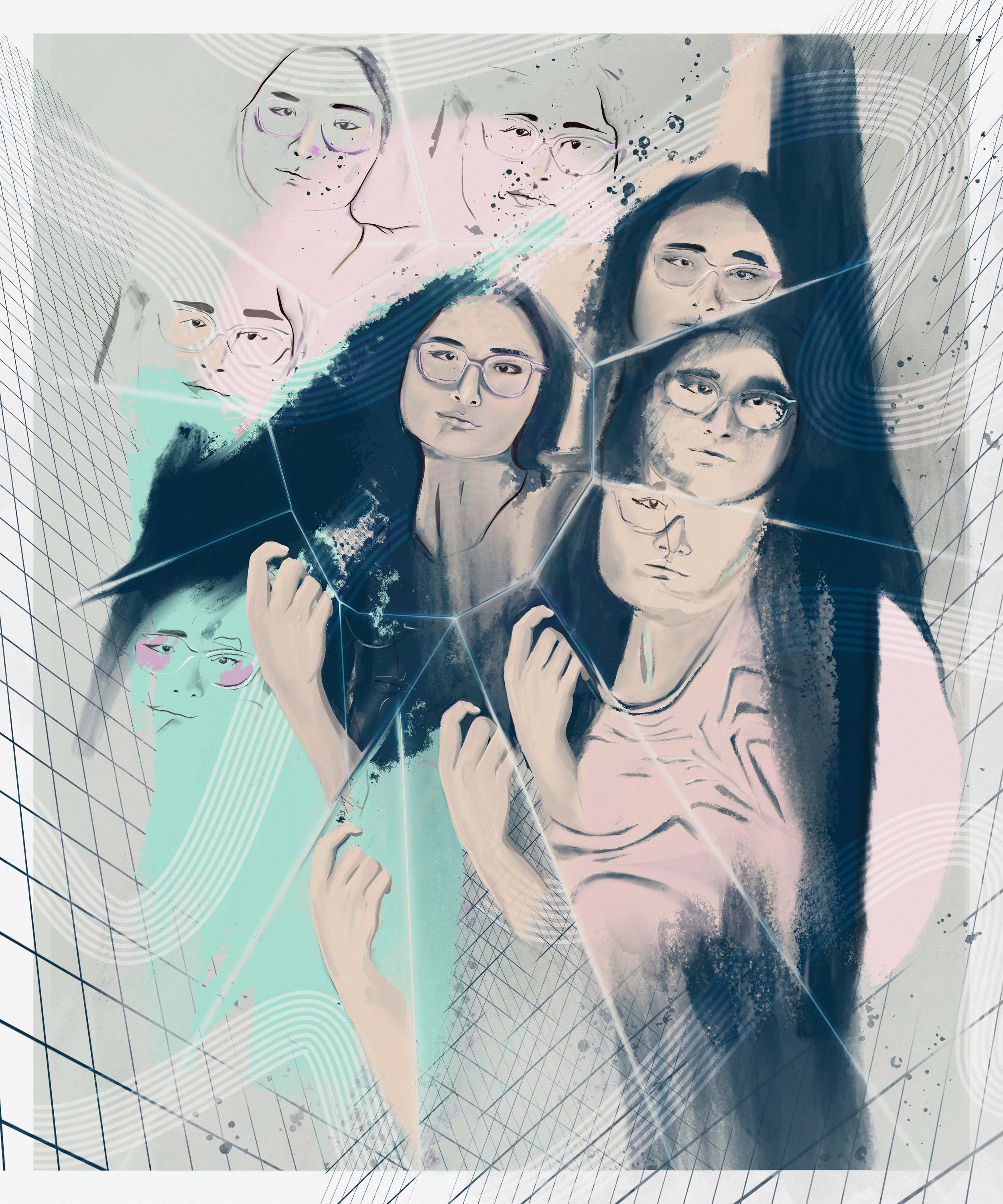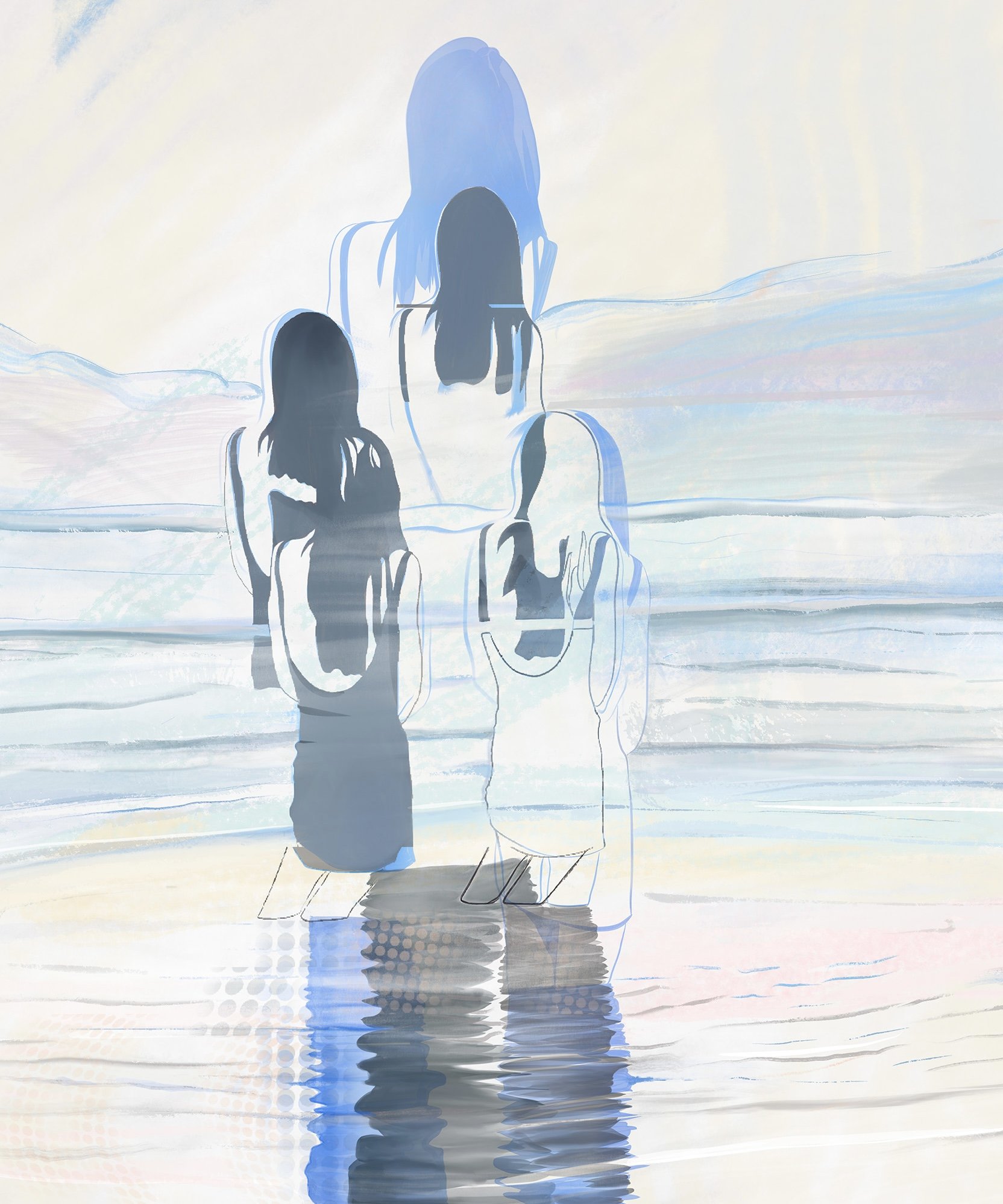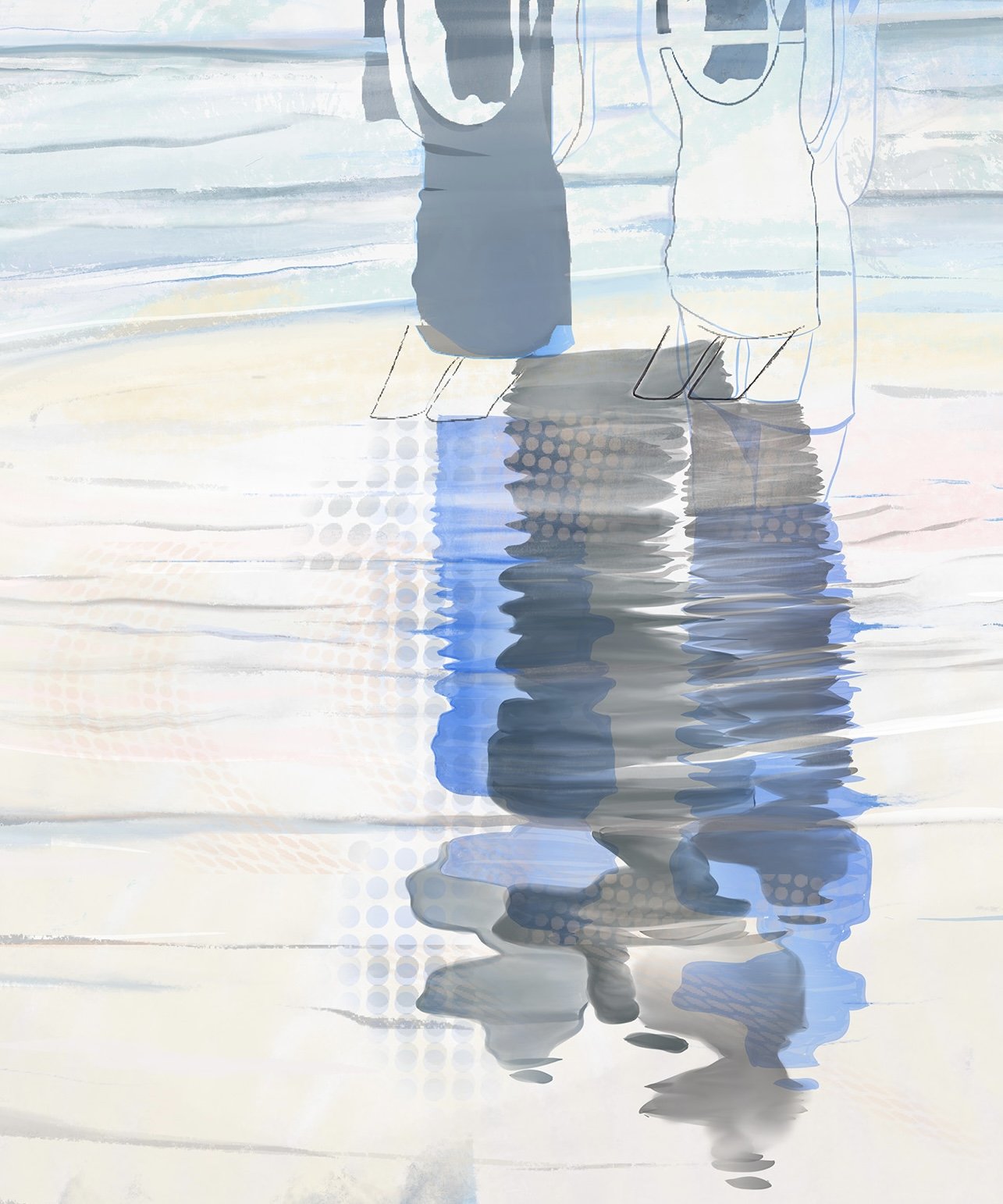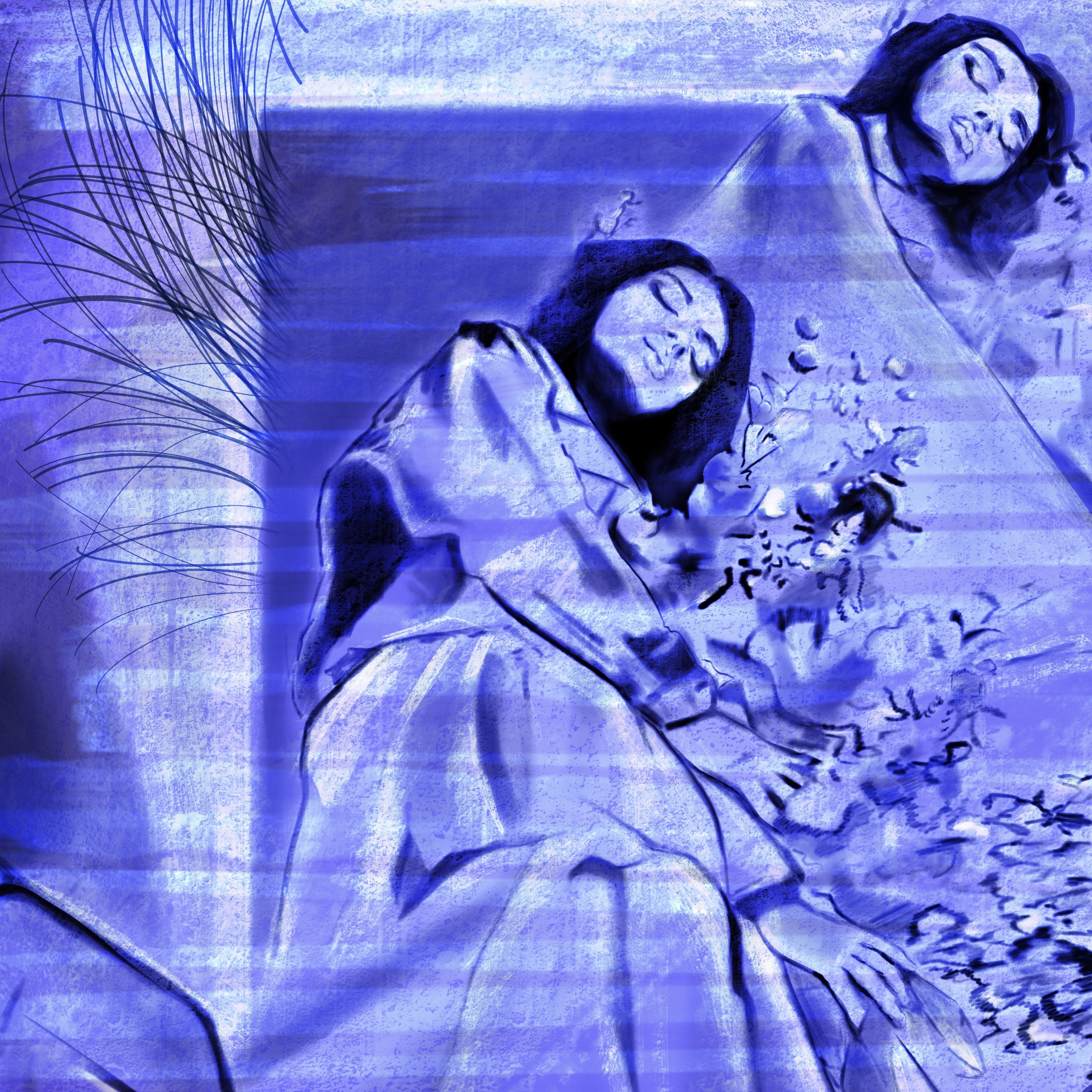Reflective Perspectives
Abstract/TLDR:
Collection Title: Reflective Perspectives
Theme: Reflection
Release Date: June 14th 2023
Total Pieces: 10
Pieces released each week: 1–2
Chain: Avalanche
Sale Type: Listing
Listing: 60 AVAX
Introducing Reflective Perspectives: a captivating new boutique collection of 1/1 digital paintings by the Mazey Moon, lovingly known as mmoonstudios. Embarking on a delicate exploration of the theme of reflection, Moon’s evocative artwork transports viewers to a realm of introspection and nostalgia through the realms of abstraction and surrealism. Each week, Campfire.exchange will unveil one to two new paintings from the collection for 8 weeks, ending on August 16th, building up to a grand finale — a mesmerizing animated audio/visual Premier Drop that promises to be a feast for the senses. The first piece in the collection will drop June 17th and there will be 10 pieces in this boutique collection.
Within Reflective Perspectives, Moon delicately weaves images of her past self with cherished friends, transporting us to a time where physical limitations were but a distant notion. Each piece encapsulates the essence of a life lived to the fullest, where boundless possibilities awaited at every turn. These artworks invite viewers to rediscover the beauty and gratitude that lies within the memories of bygone days. By reflecting on her own life experiences, Moon embraces a newfound appreciation for the openness she once possessed, cherishing the adventurous spirit that guided her through a life fully embraced.
The first piece in the collection, Thinking About Abstraction, will end it’s auction June 17th at 8 pm PST / 11 pm EST.
About the piece in the artist’s words:
Reflection is how we develop self discovery. The feelings that we have when we reflect shapes us.
Reflecting is the difference between novelty and expertise according to the Dreyfus and Dreyfus construct. Contrary to the Greek myth of Narcissus, reflection is what makes us appreciate life and allows us to build on intention. Was Narcissus unable to view the mirror as a window? Reflection is an access point to memory, a window to everything that’s you.
Thinking About Abstraction is the first piece in Reflective Perspectives. I used three figures in this piece to signify the constant change in the representation of past, present, and future because each moment has at some point been all three. I titled this piece after an album I put out in 2020. The first track on that album is titled Revisitation. I believe that art is alive and constant. Revisitation, to me, means a welcome reflection. Reflection that has a warmth to it, similar to nostalgia but more personal.
In the moment — we experience the now. The happening.
We act upon reflection: decision making.
We react upon the reflection of others.
We are all mirrors.
This piece is a self portrait at a very inspiring reflecting pool that has called me back at various points in my artistic journey. I used a photo of this pool as the cover image of my album Thinking About Abstraction. I thought it was fitting to revisit this place and let it inspire me again through memories, revisiting reflections of reflections.
Upon reflection, I was thinking about abstraction.
Frequenicity
“Frequenicity” is the second piece in “Reflective Perspectives”. The ripples represented in this digital painting are rendered to resemble water ripples and sound waves. The title is a made up word that combines “frequency” and “synchronicity”. When a sound wave or frequency meets the same frequency, the sound wave merges and the frequency is amplified. Water ripples are similar, when wakes in water meet, they can be intensified if they have the same wave pattern.
This phenomenon extends beyond mere acoustics and aquatic realms. The movement of energy, as observed, behaves similarly. Each of us emits an energy, an intangible vibe, an aesthetic that resonates with others who share commonalities or exude the right “vibe.” This mystical connection lies at the heart of the law of attraction.
The image depicted in the painting includes a female figure pushing water gently out in an abstract expanse. Above the figure, bold brushstrokes form a striking arrangement, evoking the symbolism of an equal sign. The message I’m transmitting in this image is a frequency of equality.
My identity comes into play in this piece because this is also a self portrait. Throughout this collection, I work with the theme of Reflection and use images from my past to reflect on the life I lived before disability. Reflecting on my life through my art, about the life I’ve lived, gives me an overwhelming feeling of contentment and gratitude. It’s not easy going through a change of ability but reflecting on my life, I’ve become aware of how incredibly privileged I’ve been to have the experiences I’ve had.
To come back to the symbology of the equal sign, I think there needs to be a lot more consideration to changes of ability, which every person at some point in their life will have to experience, even if it’s temporary like a broken bone. Embedding this symbol in this composition as a light source translates to the hope I feel around equality. When we allow equality to be a light source in our lives, how could we ever go astray?
143
“143” is the third piece in “Reflective Perspectives”. Friendship, as we all know, is truly hard to find. 143, is dedicated to the fierce woman depicted in this piece, Paige. My perspective of friendship has changed a bit since my first diagnosis. Every person takes news like the kind I’ve had to deliver differently. Paige is the kind of person that wants to make things easy, a people pleaser. Her and I have connected a lot through our identity of being Asian American and the expected role we’ve had to fill in society. Reflecting back on our conversations reminds me of how important it is to be a feminist and to be supportive of women, especially women who are still finding their voice.
Paige is Hmong. Her people are nomadic with no specific occupied land in our current state of observed territories. She used to stay with me while she was in town, the town where she also lived but had no specific home. She stayed in hotels, with her partner, with other friends or with me. She’s an exciting and spontaneous friend to have because she was always on the move, ready for the next adventure. She’s the kind of person that slept all day and lived her life at night. I asked her once if she could ever see herself making a life and a business of her own, basically if she could ever see herself as a normie. She looked at me rather confused and opened up to me about her philosophy on life and why she is the way she is. She told me that she doesn’t like to sleep at night because in her culture, women are kidnapped in their sleep by their future husband and this is a normal practice in Hong culture. This is the story of her parent’s coming together along with everyone else in her family.
In the composition of 143, I created segments or compartments of color. In Asian American culture, we compartmentalize what we were raised to think and act to make sense of the realities of living in contemporary American culture. The misogyny that we were raised in still influences decisions we make, like Paige, making her life at night so she doesn’t have to face whatever traumatic thoughts arise for her when the rest of us sleep. In the bottom half of the composition, a sun sets and Paige gives us a kiss while she gets ready to rule the night.
The title of this piece may be obvious to some. 143 is pager code for I love you.
Upon reflection, us women have our reasons.
If you’re reading this, you are a feminist. Thank you. 🌹
Misstory
“Misstory” is the fourth piece in “Reflective Perspectives”. Through this collection I have been diving deep into my own history in a way that’s made me a lot more introspective. This piece was made very loosely with a lot of gestures because sometimes when we go to our depths, it’s like jumping in face first into the pool that is our minds. When reflecting, there’s always a point of origin like an impact point, a source point of a memory that pulls you back to that time and that place.
The reflection in this piece is on the surface of the water while the figure is beneath the surface. Abstract shapes start to surround the figure to represent outside influences we consider when reflecting. I chose a very cool pallets for this piece. I think blues convey calmness and mystery.
Lately, I’ve been reflecting on language and how translations evolve over time. Recently I’ve become familiar with the word “herstory” being used in reference to women’s stories and the misogyny inherent in the term of “history”. The word “History” is so misogynistic that that the feminine counterpart to the word has existed and has not yet been critiqued. The contrasting word to “history” has always been “mystery”. The meaning and function of this contrast has carried through to contemporary life. Mystery has a sense of secrecy to it and women’s stories should never be kept a secret.
Upon reflection, women’s stories have always been mysteries.
Every Version of You
Every Version of You is the fifth piece in Reflective Perspectives. This piece is created to present a figure rendered in multiple different ways, as if the figure is reflected on various facets of a crystal. It highlights the many sides of everyone and the diverse roles we occupy. Reflecting and acknowledging all of these roles within our singular but expansive human existence is essential.
The model is just as important as the image. My model’s name is Ada and Ada is amazing. She’s dynamic and expressive in all the right ways. She’s my best friend, and I see myself in her, even if I don’t always fully express my emotions like she does. One of the things I admire about her the most is how she reacts genuinely. Honesty defines her, and that’s my absolute favorite thing about her.
Reflection in relationships happens between generations. Ada belongs to Gen Z, and I’m a Millennial. It brings me happiness to see Ada’s openness because it indicates that my generation might have done something right. Allowing people the space to be expressive is a newer concept in relation to the world’s history. Witnessing young Asian-American women freely exploring multiple identities and expressing themselves fills me with joy.
I hope this piece encourages viewers to reflect on the different facets of their own lives and realize how their hard work benefits the next generation.
Find Me at Lost Lake
“Find Me at Lost Lake” is the sixth piece in “Reflective Perspectives,” and is a self portrait from a very romantic experience in nature. I was born and grew up in Oregon, USA. Oregon is a beautiful state with a lot of really gorgeous views and opportunities to commune with nature. I worked from a photo for this piece which allowed me the time and space to reflect on this moment in my life where I’m standing alone in crystal clear waters, looking at the mountains with no other human or animal presence around other than me and a dear friend at dawn. Even though this moment has passed, it still lives with me. I can still remember the feeling of the crisp air and freezing water.
Upon reflection, I think I remember this moment so well because of the journey that had brought me that moment. The physical planning and lugging of camping gear, the hiking through trails that a friend had cached somewhere in her memory, the ingesting of substances that heighten senses through a ritualistic engagement of sisterhood.
Indeed, every moment that graces our lives finds a sanctuary within us. Each fragment coalesces into an intricate mosaic that guides subsequent chapters. Viewing these snapshots of yesteryears, I find my appreciation for life’s kaleidoscope deepening—an acknowledgment of the myriad encounters that have shaped my journey.
The multiplicity of the central figure mirrors the fragments of memory, elusive and sometimes subject to distortion. Ripples etched upon the water’s surface stand as tangible imprints of existence—a testament to the moments that transpired, evidence of presence, a record of happening. Blue hues envelop the frame, outlining the winding contours of distant peaks. Blue, the hue that lingers longest in the spectrum of light, I associate with memory—a parallel to the enduring imprint of recollections. Just as the sky appears blue due to the extended wavelength of light, so does memory persist in shades of blue, the color most resistant to fading. Abstract strokes, orchestrating the composition’s structure, speak to the intricacies inherent in a life fully lived. The coalescence of chaos and structure, a hallmark of existence’s dichotomy, finds presence within this work—a dance that underscores memory, remembering, and reflecting.
Faded Flowers
“Faded Flowers” is the seventh piece in “Reflective Perspectives”. “Faded Flowers” is about ex’s. Most contemporary, society loving folk have gone through a break up or two, or twenty. Break ups are probably one of the most common reflective experiences that most people have. Sometimes the people we’re with define chapters in our life, just like graduating high school, everyone has their heart broken.
“Faded Flowers” is an ode to the universal nature of heartbreak. I’m not making art to air out my dirty laundry by any means. Love and the end of it has inspired a good majority of the things I’ve made in my life. As we traverse the aftermath of a relationship’s end, we encounter the profound introspection that comes with it. This introspection is a powerful tool for growth, allowing us to learn from past connections and emerge stronger with a better understanding of who we are as individuals and how we love. This piece explores the spectrum of emotions tied to former relationships, including the evolution of feelings from love to loss, to acceptance, to a new kind of care.
The piece is rendered to resemble a marker-ed out page with a double-exposed image depicting a woman looking down at a mirror or perhaps a collection of printed photographs of herself holding a bouquet of flowers.
Upon reflection, love hurts, but damn it feels
good.
Memories of Diplopia
"Memories of Diplopia" represents the eighth piece in "Reflective Perspectives." Diplopia, a term denoting double vision, serves as the central theme. This composition delves into the diverse facets of memories, specifically their variability contingent upon the perspectives individuals construct from past experiences.
As an artist with a disability, I derive immense pleasure from revisiting and immersing myself in the memories of my fully able-bodied days. These cherished recollections invariably undergo a creative transformation in my mind. For instance, I find profound satisfaction in reminiscing about the bike rides I’d take on the weekends. My route often led me from my home to Marine Drive in Portland, Oregon, where I would ride along the Columbia River’s shoreline. Strangely, when I revisit these moments in my mind, the presence of others who also relished the riverbank seems to fade away. All I remember is the river, the birds, the land, and me. I wonder why I always remember the most ideal situation from events and happenings.
Even as I dream about the future, my aspirations remain aligned with the dreams I harbored when I possessed full physical capabilities. However, the future I envisage is fragmented, and I confront this fragmentation daily. Within this vision of the future, there lingers a ghost of diplopia—a stark contrast between the 'ideal' me I dream of and the reality of my current abilities. This is a struggle I believe we all grapple with—the disparity between our dreams and the constraints of reality.
Upon reflection, I love the act of dreaming itself. While my dreams may not always align with reality, it is the journey that truly matters. Life inevitably presents us with situations beyond our control, but it is our response to these circumstances that defines us. So, I encourage you to keep dreaming. The future may hold even greater possibilities than you could ever imagine.
Microcosmic Watercolor; Terrestrial Romanticism
“Microcosmic Watercolor; Terrestrial Romanticism” is the ninth piece in “Reflective Perspectives.” At first glance, "Microcosmic Watercolor; Terrestrial Romanticism" appears to be a delicate, almost dreamlike tableau. The observer is drawn into a serene, watery realm, where pastel hues merge seamlessly with the soft caress of water ripples. These ripples, rendered in intricate detail, carry an almost hypnotic quality, invoking a sense of tranquility.
Within this miniature universe, elements of terrestrial romanticism are expressed with color and gesture. The hands, gently placing roses onto the water's surface. The roses, with their neutral colors contrasting against the vivid pastels, speaking to the life the water gives.
As the roses are carefully placed into the water, they create concentric ripples that echo outwards. Each ripple signifies not only the physical act of placing the roses but also the emotional reverberations that love and connection can bring. Microcosms are every little action we take. Even the smallest gestures of love and affection have a profound impact, resonating through the interconnected web of life.
"Microcosmic Watercolor; Terrestrial Romanticism" invites viewers to ponder the intricate dance of life, love, and nature. It encourages us to reflect on the often-overlooked beauty of the world's tiniest wonders and the profound significance they hold. In the grand tapestry of "Reflective Perspectives," this piece a gentle reminder that sometimes, it is in the smallest details that we find the most profound insights about ourselves and our world.
Upon reflection, this planet is beautiful and we should enjoy it (while we still can).
This will be updated as the pieces get released. Follow me on Twitter to connect.





















